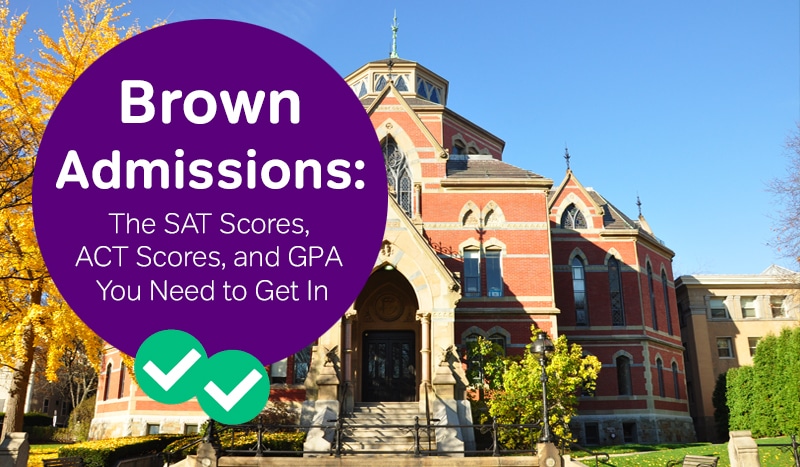
So you want to be a Brunonian? (I know you were probably hoping for “Brownie”—so was I. Sorry.) With alumni ranging from John F. Kennedy Jr. to Emma Watson, you’re in good company. First, though, you’ll need to figure out how to get into Brown. It’s not easy: Brown SAT scores are high, and so are Brown ACT scores. Take a look at Brown’s admissions statistics.
Brown at a Glance
| Brown SAT Scores (composite, middle 50%) | 1405-1570 |
| Brown ACT Scores (composite, middle 50%) | 31-35 |
| Brown admissions rate | 6.6% |
| Brown GPA average | 94% of students in the top 10% of their class |
Those numbers are high, but it’s important to remember that if you’re willing to put in the work, you’ll give yourself the best shot at getting into this Ivy League school.
So…want to learn more about how to get into Brown?
Brown SAT Scores
As you might imagine for a school with an admissions rate of 6.6% (more than 38,000 students applied for admission in the 2018-2019 admissions cycle!), Brown’s SAT scores are stratospheric. These are the middle 50% Brown SAT scores:
| Math | 700-790 |
| Evidence-Based Reading and Writing | 705-780 |
Let’s look a little more closely at those scores. These numbers represent the scores of accepted students in the 25th-75th percentiles. That does mean that, yes, 25% of students admitted to Brown scored a perfect 800 on the Math section of the SAT. But it also means that 25% of students admitted scored below 700 in this section.
For the best chance at getting into Brown, it’s a good idea to get your SAT scores as high as possible: in the 50th percentile is great. When admissions are this competitive, great SAT scores–or even a perfect SAT score–do not guarantee you a spot in Brown’s incoming class—but less-than-outstanding SAT scores do assure you that catching the eye of the admissions officers will be all the more difficult.
At this point, it’s probably not much of a surprise that Brown ACT scores are extremely high as well. Wait no longer: here are the middle 50% of Brown ACT scores.
| English | 33-35 |
| Math | 30-35 |
| Composite | 31-35 |
(There are two additional sections to the ACT, Science and Reading, but Brown hasn’t provided information about those scores.)
As with Brown SAT scores, remember that Brown ACT scores show the middle 50% of admitted students’ scores. Can you get into Brown with a composite ACT score of less than 31? Definitely—25% of Brown’s class of 2022 did. But is scoring a perfect ACT score going to help you? Well, 25% of Brown’s class of 2022 did.
It’s also important to remember that you don’t know the exact circumstances of students who scored under 31 on the ACT (or 1405 on the SAT). These students may be the fifth generation in their family to attend Brown. They may have written acclaimed novels, competed in the Olympics, or overcome amazing odds to succeed. The truth is that Brown’s admissions rate makes it so competitive that it is likely these types of students comprise the lowest 25% of standardized test-takers admitted.
Should this put you off applying if you’ve scored lower than 31 or 1405? Absolutely not! Should it make you consider taking the test again or seeing if you’d score better on the other test? Definitely.
Brown Acceptance Rate
Brown’s admissions rate was 6.6% in 2018. This was an all-time low, down from 13.9% in 2008 and 8.3% in 2017. The general trend in Ivy League admissions holds true for Brown admissions, too: the school has become increasingly selective in the past decade (and over the past 50 years). The number of applicants has also risen, from around 20,000 in 2008 to more than 38,000 in 2018. Should this deter you from applying? No! Somebody has to be in that 6.6%—why not you?
If you want to up your chances of getting in, Mike M. from Transizion has some advice for you:

“The main point of your application should be to convince Brown admissions that you have agency over your own path. So, how exactly can you convince them of your independence? First off, actively pursue your educational interests outside of school. Finding local community activities that match with your interests is a great way to show that you are willing to seek out our own opportunities to learn. If you are interested in biology, volunteer at your local teaching hospital. If you want to study history, many museums and libraries offer relatively cheap or free classes you could attend. Basically, any outside sources of learning that can facilitate your educational goals would look good here, but just make sure you mention them somewhere in your application, otherwise, they won’t know all the hard work you’ve put into self-education.”
Brown GPA Average
Brown’s doesn’t provide a GPA average for prospective students, although other sites may estimate GPAs. However, the weighting of various classes’ grades at different high schools means that GPAs become relatively meaningless without context: what does an average GPA of 4.05 mean for prospective students? Not very much.
However, although we don’t have a Brown GPA average, we do have something more telling: top tens. No, it’s not a listicle. Instead, Brown provides statistics about the percentage of its admitted students whose GPAs were in the top tenth of their high school class. In the past ten years, this has always been upwards of 90% of Brown’s admitted students. In 2018, 94% of Brown’s admitted students were in the top ten percent of their high school class in terms of GPA. If you’re not sure where you stand in terms of your school, check with your guidance counselor. Again, keep in mind that being in the top 10% of your class doesn’t guarantee you admission—but not being in it can have a detrimental effect on your chances of getting in.
Not sure about your GPA? Calculate it here!
Brown Freshman Profile
So just who does end up going to Brown? Brown’s newspaper freshman profile for the class of 2023 breaks down the states with the most admitted students were California, New York, Massachusetts, New Jersey, and Texas, while foreign countries with the most admitted students were China, Canada, India, South Korea and the United Kingdom.
Brown Other Admissions Requirements and Info
When you look at just the numbers, Ivy League admissions can be a little intimidating, and Brown is no exception. However, Brown admissions officers do let in thousands of students every year. When so many students apply, the question becomes: how are they selected?
Increasingly, distinguishing yourself in a particular area has become important to the most selective schools. This doesn’t mean that you have to be a novelist or Olympic athlete, but it does mean that schools like Brown are looking for passion, dedication, and talent in whatever field does inspire you. Emphasizing this in the areas of the application you have the most control over, including the essays and letters of recommendation (though don’t be too prescriptive with those!), is key to getting in.
Brown Admissions FAQ
What are my chances of getting accepted to Brown as a transfer student?
Brown’s transfer admissions have historically been (relatively) strong. In 2017, Brown admitted 95 transfer students. However, more than 1800 students applied. If your high school grades weren’t stellar, applying to Brown as a transfer student is definitely an option, but keep in mind that Brown admissions rates for transfer students are lower than for general undergraduate admission.
I’m the first person in my family to attend college. Will this hurt my chances of getting in?
On the contrary—Brown admissions rates are higher for first-generation college attendees than others. 13% of Brown’s 2021 class were the first in their family to attend college.
I live in an area of the country without a lot of students accepted to Brown. Should I bother applying?
Absolutely. A lot of the time, fewer students from areas like the Plains States apply than students from, say, New England. Part of this may simply be the cost of travel and the distance away from home, and some of it can also be attributed to the higher populations in states like California and New York. In other words, students aren’t getting rejected from Brown because of where they live.
How to Get Into Brown
How to get into Brown? Show that you are passionate about your areas of interest; demonstrate that you have a stellar academic record (or one that’s increasingly improved); and submit scores within the middle 50% (or higher) of Brown SAT scores or Brown ACT scores. Brown admissions are tough, but you can maximize your chances of getting in by standing out using those three keys. (Hint: If you’re worried about your test scores, consider Magoosh’s SAT or ACT test prep—we have a score guarantee for both tests and have helped thousands of students get into their dream schools!)





Leave a Reply